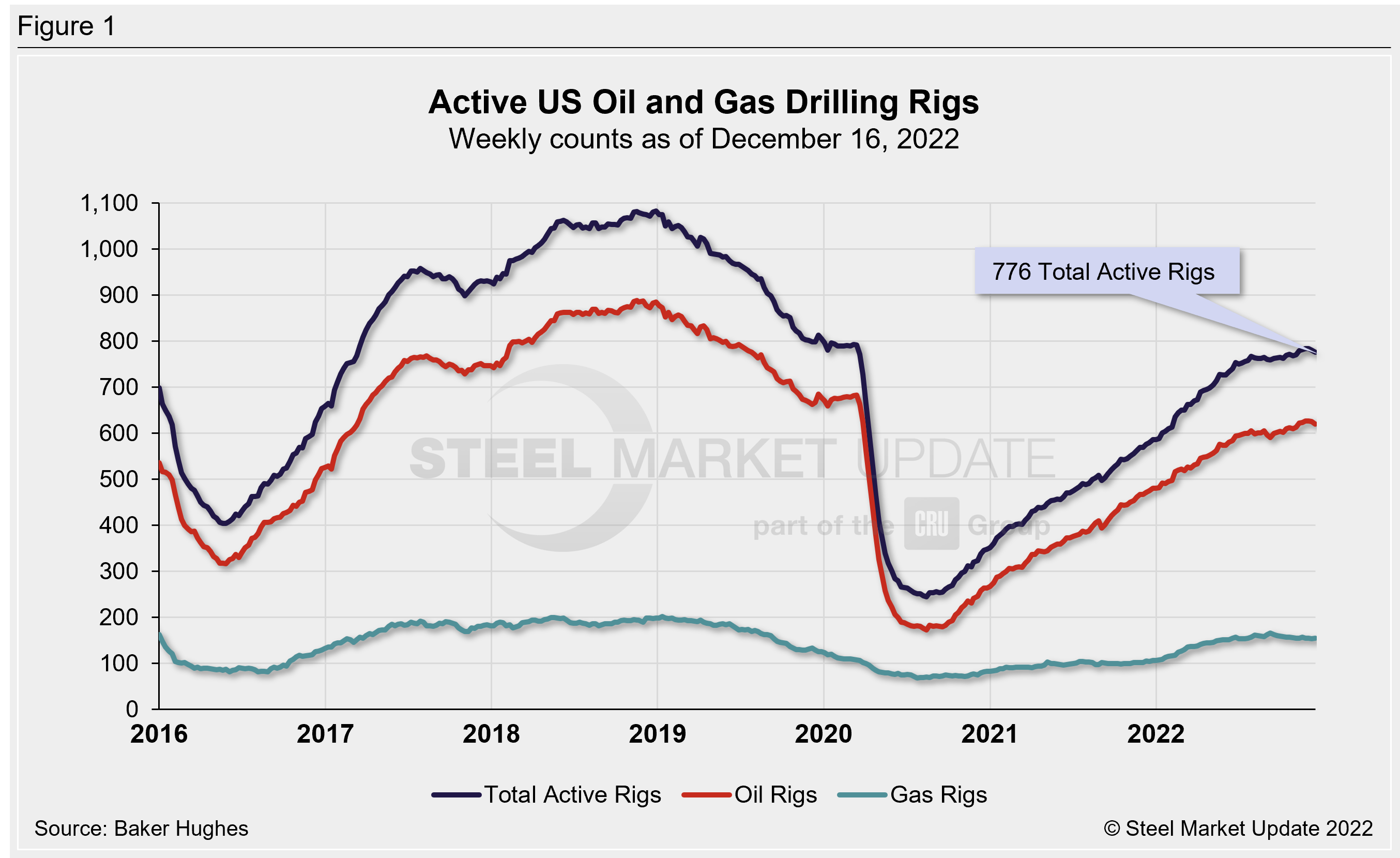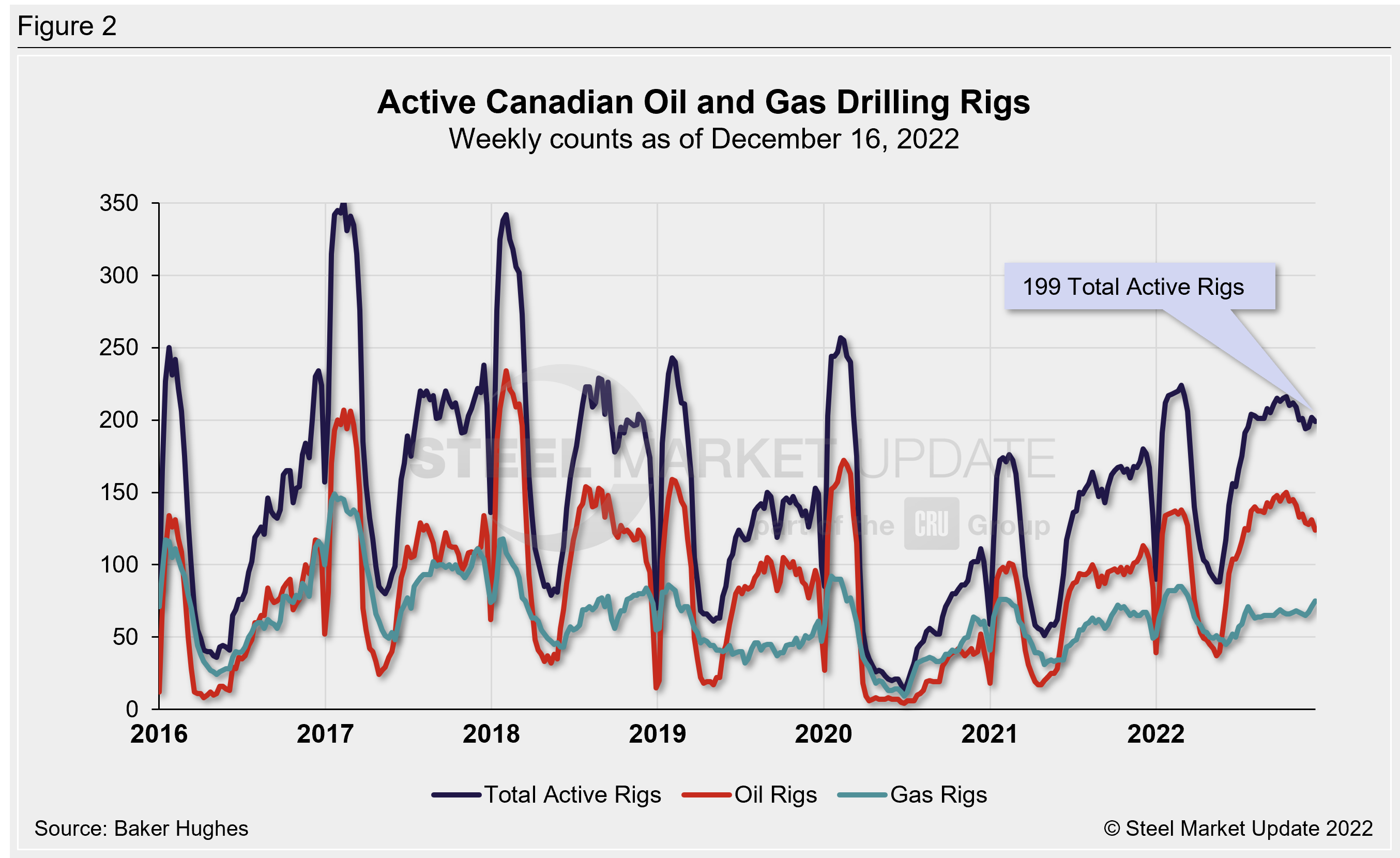Trade Cases
US, Canadian Rig Counts Slip
Written by Becca Moczygemba
December 18, 2022
The number of active drilling rigs dipped this week in the US and in Canada, according to data from oilfield services company Baker Hughes.
The number of oil and gas rigs in operation is important to the steel industry because it is a leading indicator of demand for oil country tubular goods (OCTG), a key end market for steel sheet.
Total rig counts in the US declined by four this week to 776 total rigs in operation. The number of active oil rigs slipped to 620, down five from the week prior even as the number of as gas rigs increased by one to 154. Miscellaneous rigs were unchanged. Compared to this time last year, the US count is up 197 rigs, with oil rigs up 145, gas rigs up 50, and miscellaneous rigs up two.


The Canadian rig count dropped by three this week to 199 rigs, with oil rigs down seven, gas rigs up four, and miscellaneous rigs unchanged. This week’s Canadian count is up 32 rigs compared to levels one year ago, with oil rigs up 20, gas rigs up 13, and miscellaneous rigs down one.

The international rig count decreased by one to 910 rigs for the month of November and is up 93 rigs from the same month one year ago.
For more in-depth information on the energy market, Steel Market Update publishes an “Energy Update” report each month covering oil and natural gas prices, detailed rig count data, and oil stock levels. Our November report is available here for Premium members.
For a history of both the US and Canadian rig count, visit the Rig Count page on the Steel Market Update website here.
About the Rotary Rig Count
A rotary rig is one that rotates the drill pipe from the surface to either drill a new well or to side track an existing one. Wells are drilled to explore for, develop and produce oil or natural gas. The Baker Hughes Rotary Rig count includes only those rigs that are significant consumers of oilfield services and supplies.
The Baker Hughes North American Rotary Rig Count is a weekly census of the number of drilling rigs actively exploring for or developing oil or natural gas in the US and Canada. Rigs considered active must be on location and drilling. They are considered active from the time they break ground until the time they reach their target depth.
The Baker Hughes International Rotary Rig Count is a monthly census of active drilling rigs exploring for or developing oil or natural gas outside of the US and Canada. International rigs considered active must be drilling for at least 15 days of the month. The Baker Hughes International Rotary Rig Count does not include rigs drilling in Russia or onshore in China.
By Becca Moczygemba, Becca@SteelMarketUpdate.com

Becca Moczygemba
Read more from Becca MoczygembaLatest in Trade Cases

Price: Reciprocal tariff changes and potential new tariffs for Brazil, Canada, others
Trade issues do not seem poised to leave the headlines anytime soon. And as recent developments show, the administration’s tariff policy remains ever-changing.

Bessent on Vietnam: 20% tariff stands, Section 232 protections apply
US Treasury Secretary Scott Bessent told reporters that tariffs for Vietnamese imports to the US are 20% and "specific industries" have trade protections under the Section 232 tariffs.

Steel groups welcome passage of budget bill
Steel trade groups praised the passage of the Big Beautiful Bill (BBB) in Congress on Thursday.

Canada moves to curb steel imports with TRQs
Canada has implemented tariff-rate quotas (TRQs) on steel imports to help stabilize its domestic market.

Commerce launches probe into unfairly traded rebar imports
Here are the details and a case timeline for the rebar trade case recently initiated by the Commerce Department.
